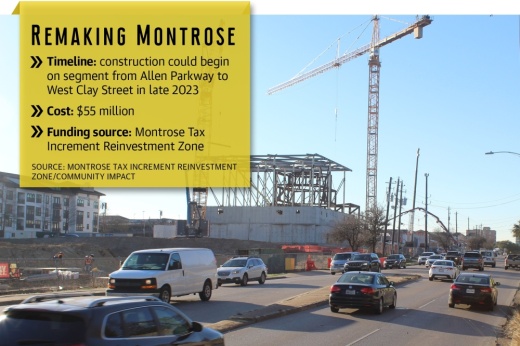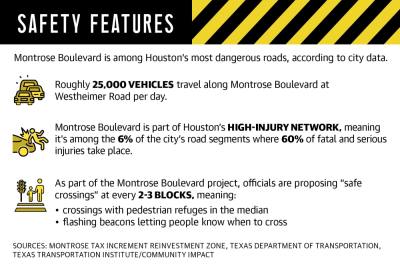With development booming along Montrose’s namesake corridor, local officials are looking to invest more than $50 million dollars in a wide-spanning project focused on making the road safer for all users.
The effort is being led by the Montrose Tax Increment Reinvestment Zone, or Montrose TIRZ, a governmental entity composed of local residents and business owners who carry out projects in the area with approval from the city of Houston.
The TIRZ is targeting the segment of the road between Allen Parkway and I-69 for a host of improvements ranging from wider sidewalks and safer crossings to upgraded aesthetics.
“When we get into designing, we’re going to be designing this block by block, tailored to whatever the adjacent development is along the corridor,” said Muhammad Ali, principal with Gauge Engineering, at a December presentation.
Gauge has been tasked by the TIRZ to carry out design work.
The proposed changes are being driven by safety concerns on Montrose as new developments underway set the stage for even more activity in the future. Among the key projects that could reshape the street over the next five years are the mixed-use development Montrose Collective, which opened in 2022; the Ismaili Center Houston, an 11-acre gathering space for Muslims coming in 2024 near Allen Parkway; and an unnamed mixed-use project by the developer Skanska being planned at Westheimer Road.
The TIRZ hosted a public meeting Jan. 23 where residents provided feedback on the proposed plans. Some residents said they were focused on pedestrian safety.
“It would be nice if there was more done to slow down cars turning off Montrose Boulevard, but overall, compared to its current state, I was impressed,” said Dougie Steinbach, who lives in the Upper Kirby area but goes for runs around Montrose.
Project details
The project spans roughly 2 miles from Allen Parkway to I-69. It will involve a full roadway and drainage reconstruction with costs estimated at $55 million.
From I-69 to Westheimer Road, proposals call for taking out an 11-foot center turn lane and adding a 14-foot median with trees. The existing 4-foot sidewalks would be widened to 10 feet with a 6-foot buffer to the street, which officials said would create opportunities for more tree plantings.
Ali described the segment from Westheimer to Dallas Street as a difficult walking environment, citing large utility poles and 4-foot-wide sidewalks in poor condition.
Proposals call for narrowing the median from 30 feet to 20 feet and using that space to expand the pedestrian area with wider sidewalks. Teams would work to preserve as many trees in the median as possible during the narrowing process, Ali said.
“We want to protect and preserve as many trees as we can, but also add more trees that work with the planned configuration and provide shade for users,” he said.
From Dallas to Allen Parkway, a new 6-foot sidewalk would be added where none currently exist on the west side of the street, helping people get to and from Buffalo Bayou trails. An existing sidewalk on the east side of the street would be widened into an 11-foot path for walking and biking.
For the stewards of the Magnolia Cemetery, located on the west side of Montrose Boulevard south of Allen Parkway, they said the changes are worth it, even if they come with growing pains. The cemetery has among the longest borders with the proposed improvements among property owners.
“We were concerned about keeping our cemetery whole,” said Glen Telge, whose family have been stewards of the cemetery since the 1920s. “We were told there was not going to even be any talk of [encroachment]. We’re excited about it.”
Safety first
Most of Montrose falls within the city of Houston’s “high injury network”—a term used to refer to the 6% of the city’s road segments where 60% of fatal and serious vehicle and pedestrian injuries take place. From 2014-2018, the stretch of Montrose from Bomar to Branard streets had five crashes with serious injuries, including three involving pedestrians, according to city data.
Because of that, TIRZ Chair Joe Webb said improving safety is a major consideration in project plans.
While the city of Houston ultimately has the authority of setting the speed limit, Ali said they want to design the road in a way that encourages people to drive around 30 mph. Montrose currently features sections where the speed limit is 30 mph and 35 mph.
Plans also call for having “safe crossings” at roughly every two to three blocks, meaning crossings with pedestrian refuges in the median or with flashing beacons letting people know when it is safe to cross. West Clay Street at Montrose was cited as one intersection that would be improved.
Ali said Gauge also plans to work with the Metropolitan Transit Authority of Harris County on strategically placing bus stops so buses have more space. Broader plans also call for improving drainage. Crews will install 10-by-10-foot box culverts underground to meet city drainage criteria.
Webb said the TIRZ has the funding capacity to finance the project but plans to apply for federal grants to help pay for it, which he said would free up money for the TIRZ to use on other road improvements.
“Grant funding is a process that will hopefully allow us to do this plus other projects as well,” he said at the December presentation.
Design work began on the segment of the project from Allen Parkway to West Clay Street in January. Construction could begin on that segment in late 2023 and be finished by late 2025. The timeline for the segment from West Clay to I-69 is to be determined.







